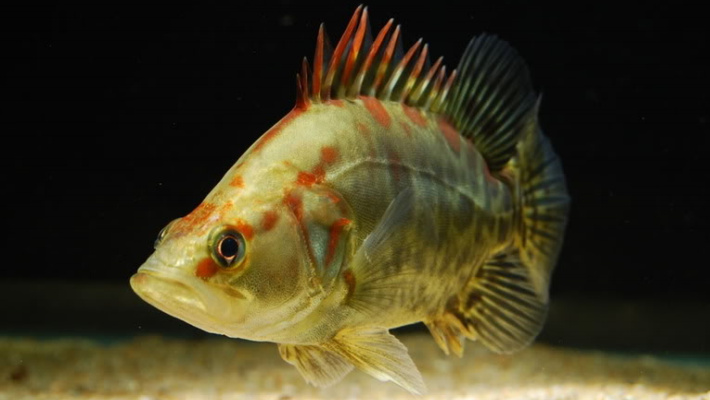|
Microsmatic
fish are represented by numerous freshwater and marine species in which the
well developed visual system provides most of the behavioural responses in
comparison with the less developed chemosensory system. Visually guided diurnal
or twilight predators as well as visually guided bentivorous and planktivorous
species form this group of fish. The chemosensory system of microsmatic fish is
active in providing their reproductive behaviour, social behaviour, spatial
migration, partially anti-predator behaviour and is weak or indifferent in
providing feeding responses.
Here, we
consider esociform fish.
Esocidae
5 species: Esox americanus, E. lucius, E. masquinongy, E. niger, E. reicherti
Fresh
waters of boreal Eurasia and Northern America
Northern
pike, E. lucius, and other
representatives of Esox genus,
including Amur pike, E. reicherti,
and some North American species, are apexpredators with the well developed
vision and lateral line system.
According
to data received by Devitsyna & Malyukina (1977) in the
electrophysiological experiments, the olfactory system of pike, E. lucius, responds only to conspecific
sexual pheromones (gonad extracts), but does not respond to conspecific odors,
pure water and feeding substances like fish blood or tissue extracts. In
feeding behaviour, musky, E. masquinongy,
use vision and seismosensory system (New et al., 2001).
Pike larvae
decrease the frequency of their attacks on zooplankters and show other
anti-predator responses to chemical cues of Eurasian perch, Perca fluviatilis (Lehtiniemi, 2005;
Lehtiniemi et al., 2005). It is also shown that pike are attracted by alarm
pheromone of fathead minnow, Pimephales
promelas (Mathis et al., 1995; Chivers et al., 1996; indirect data by
Wisenden & Thiel, 2001).
Dalliidae
3 species: Dallia admirabilis, D. delicatissima, D.
pectoralis
Fresh
waters of Bering Sea basin
Blackfish
primarily feed on crustacens (ostracods, cladocerans, copepods) and insect
larvae (ephemeropterans, hemipterans, dipterans, odonates), with the occasional
cannibalism and consumption of juvenile pike, E. lucius (Chlupach 1975).
However,
leading sensory systems in feeding and reproductive behaviours of blackfish are
unknown.
In winter
with the oxygen lack, blackfish concentrate in the vicinity of holes in the
ice, being easy to capture with the simple funnel-shaped traps made from strips
of tamarack or spruce (Andersen et al., 2004). In spring and fall, blackfish are also easily caught while
migrating to and from their summer habitats by placing the traps in narrow
channels, it is appear these traps are not baited.
Umbridae
4 species: Novumbra hubbsi and Umbra krameri, U. limi, U. pygmaea
Fresh waters
of Europe and Northern America
According
to rare observations, feeding behaviour of mudminnows is rather provided by
vision. For example, European mudminnow, U.
krameri, eat in an aquarium only living and moving invertebrates such as
cladocerans, copepods, Chaoborus
larvae, chironomid larvae, culicid larvae, mayflay larvae, Acellus aquaticus and tubificid worms (Kováč, 1997). Cannibalism
and hunting on juvenile fish in the nature are occasionally observed. However, Glasgow
& Hallock (2009) report that Olimpic mudminnows, Novumbra hubbsi, are caught by the minnow traps baited with the
chironomid larvae baits (15 g of chironomid larvae per one funnel-shaped trap).
So, the problem of sensory providing of feeding behaviour in mudminnows is
currently unclear.
On the
other hand, chemical cues may play an important role in social and
anti-predator behaviours of mudminnows. Indeed, central mudminnows, U. limi, demonstrate anti-predator
behaviour in response to conspecific chemical alarm cues (Wisenden et al.,
2007). Yet, mudminnows display comlex reproductive behaviour, from territory
guarding to parental care (Hagen et al., 1972; Bohlen, 1995; Kováč, 1997). Reproductive
behaviour of mudminnows must be supported by chemical cues, another problem that awaits further investigations.
Perhaps,
blackfish and mudminnows must be considered as mediosmatic fish.
Basic References
Andersen D.B., Brown C.L., Walker R.J., Elkin K. 2004. Traditional
ecological knowledge and contemporary subsistence harvest of non-salmon fish in
the Koyukuk River
drainage, Alaska.
U.S. Fish and
Wildlife Service, Final Report for Study
01-100-3, 164 p.
Bohlen J.
1995. Laboratory studies on the reproduction of the European mudminnow (Umbra krameri
Walbaum), 1792. Annalen des
Naturhistorischen Museums in Wien 97, 502-507
Chivers
D.P., Brown G.E., Smith R.J.F. 1996. The evolution of chemical alarm
signals: attracting predators benefits alarm signal senders. The American Naturalist 148, 649-659
Chlupach,
R.S. 1975. Studies of introduced blackfish in waters of southcentral Alaska. Annual
Performance Report for Sport Fish Studies, volume 16, study G-II-K. Alaska
Department of Fish and Game,
62-78
Devitsyna
G.V. 1977. Comparative study of the olfactory analyser morphology in
fishes. Journal of Ichthyology 17, 129-139
Glasgow J., Hallock M. 2009. Olympic
mudminnow (Novumbra hubbsi) in the
Green Cove Creek Watershed, Thurston
County, Washington:
Distribution and recommendations for protection. Washington Department of Fish and Wildlife, 18 p.
Hagen D.W., Moodie G.E.E., Moodie P.F. 1972. Territoriality
and courtship in the Olympic mudminnow (Novumbra
hubbsi). Canadian Journal of
Zoology 50, 1111-1115
Kováč V.
1997. Experience with captive breeding of the European mudminnow, Umbra krameri Walbaum, and why it may be
in danger of extinction.
Aquarium Sciences and Conservation 1, 45-51
Lehtiniemi
M. 2005. Swim or hide: predator cues cause species specific reactions in
young fish larvae. Journal of Fish
Biology 66, 1285–1299
Lehtiniemi M., Engström-Öst J., Viitasalo M. 2005. Turbidity
decreases anti-predator behaviour in pike larvae (Esox lucius). Environmental
Biology of Fishes 37, 1-8
Mathis
A., Chivers D.P., Smith R.J.F. 1995. Chemical alarm signals: predator
detterents or predator attractants? The
American Naturalist 145, 994-1005
New J.G., Fewkes L.A., Khan A.N. 2001. Strike feeding behavior in the
muskellunge, Esox masquinongy:
contributions of the lateral line and visual sensory systems. Journal of Experimental Biology 204,
1207-1221
Wisenden
B.D., Thiel T.A. 2001. Field verification of predator attraction to minnow
alarm substance. Journal of Chemical
Ecology 28, 417-422
Wisenden B.D.,
Karst J., Miller J., Miller S., Fuselier L. 2007. Anti-predator
behaviour in response to conspecific chemical alarm cues in an esociform fish, Umbra limi (Kirtland 1840). Environmental Biology of Fishes 82,
85-92
|








 SUBSCRIBE
SUBSCRIBE


